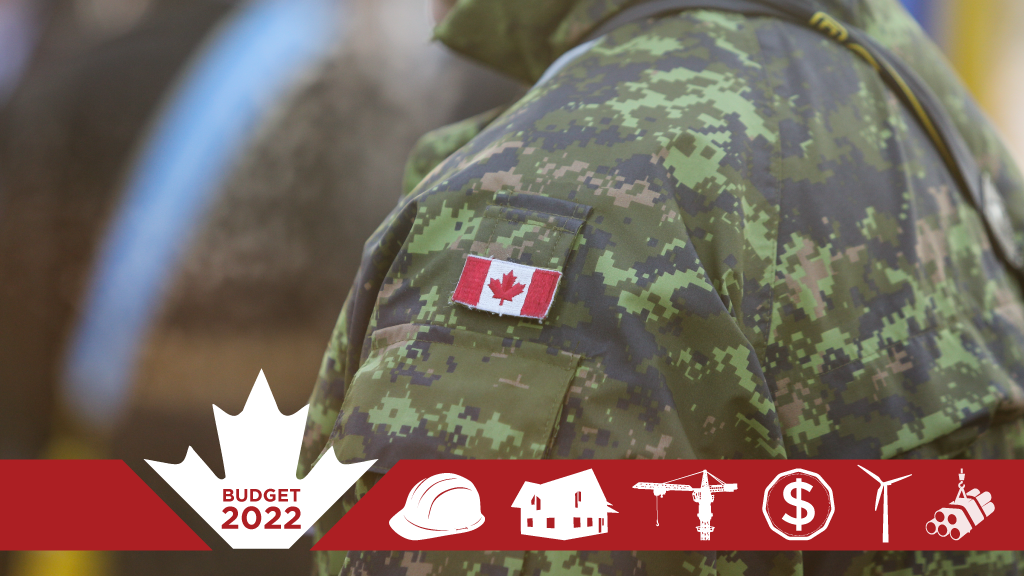The federal government’s 2022 budget made substantial commitments to national defense in a newly dangerous world while expanding existing initiatives.
Budget 2022 cited not only the Russian invasion of Ukraine but also the ongoing effects of climate change, COVID-19 and the rise of confrontational authoritarian regimes as challenges to both Canada and the stability of the post-Second World War order.
The government will provide $8 billion in new defense spending over the next five years as well as continuing with the planned increases introduced in the “Strong, Secure, Engaged” defence policy introduced in 2017 which laid out defense priorities over a 20 year horizon.
The budget proposes providing $6.1 billion over five years starting in 2022-2023 with $1.3 billion in remaining amortization and $1.4 billion of ongoing funds to the Department of Defense “in order to meet our defence priorities, including our continental defences, commitments to our allies, and for investments in equipment and technology to immediately increase the capabilities of the Canadian Armed Forces.”
The federal Liberal government promised another $500 million in military aid as well as other financial assistance to Ukraine.
Budget 2022 also announced a defence policy review in order to update the current policy “in support of its broader international priorities and the changed global environment.”
“The review will focus on, amongst other things, the size and capabilities of the Canadian Armed Forces; its roles and responsibilities; and making sure it has the resources required to both keep Canadians safe and contribute to operations around the world,” the budget stated.
Budget 2021 had previously committed $252.2 million over five years to sustain existing continental and Arctic defense capabilities while planning for the North American Aerospace Defense Command (NORAD)’s future development.
An August 2021 joint statement between Canada and the United States established priorities for NORAD modernization including advanced all-domain surveillance and intelligence, modernized command control, and communications, improved capabilities to deter and defeat threats and increased research, development, and innovation.
Budget 2022 also proposed $100.5 million over six years starting in 2021-2002 with $1.7 million in remaining amortization and $16.8 million of ongoing funding to strengthen Canadian Armed Forces leadership, modernize the military justice system, bring into force the Declaration of Victims Rights as set out in the National Defence Act, undertake engagement and consultation on culture change and enhance restorative services, including dispute resolution and coaching services.
Approximately $3 million of this amount will be sourced from existing resources over three years starting in 2021-22.
The 2022 budget also proposes $144.3 million over five years starting in 2022-2023 with $31.6 million ongoing to expand Canadian Armed Forces health services and physical fitness programs in order to be more responsive to women and gender-diverse military personnel.
“This builds on funding from Budget 2021 of $236.2 million over five years, starting in 2021-22, and $33.5 million ongoing for the Department of National Defence and Veterans Affairs Canada to support efforts to eliminate sexual misconduct and gender-based violence in the military and support survivors,” the budget document stated.
The budget also highlighted cyber security as a priority, building on 2018’s National Cyber Security Strategy. Budget 2022 will provide $875.2 million over five years beginning in 2022-23 and $238.2 million ongoing for additional cybersecurity measures.
Those measures include $263.9 million over five years, starting in 2022-23, and $96.5 million ongoing to enhance abilities to launch cyber operations to prevent and defend against cyber-attacks through the
Communications Security Establishment (CSE), $180.3 million over five years, starting in 2022-23, and $40.6 million ongoing to enhance CSE’s abilities to prevent and respond to cyber-attacks on critical infrastructure.
As well, $178.7 million will be spent over five years starting in 2022-23, and $39.5 million ongoing to expand cyber security protection for small departments, agencies, and Crown corporations; and $252.3 million over five years, starting in 2022-23, and $61.7 million ongoing for CSE to make critical government systems more resilient to cyber incidents.











Recent Comments